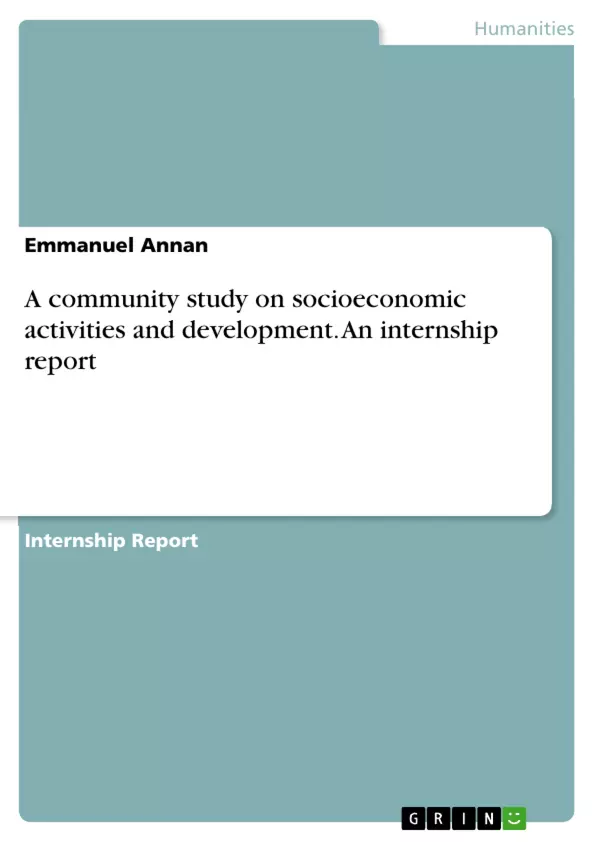The study is mainly concerned with the location of the community of No.1 in the F district, it gives responses to the questions related to ‘what’, ‘why’, ‘who’, ‘how’ in relation to socio-political organization. The findings of the study is basically for academic purposes and also serve as base for other planners, policy makers and public administrators and developmentalist in local and regional areas. Give insight for the town administrators about the existing and emerging socio-economic challenges of the community members in relation with the socio-economic services provided by the town administration. It would also address environmental issues of the community. The study contains five chapters, thus chapter one deals with the location of the community, community layout, sketch map of Ghana, sketch map, chapter two talks about the socio-political organization, history of the community, the languages spoken by the people, the social structures and in the community, traditions, Custom, Festivals, Taboos, ethnicity, kinship, chapter three addresses the environment, sanitation and source of water, the state of the vegetation, bushfires, type of houses built, chapter four tackles the economic activities of the people, various types of occupation and their challenges, tourist attraction sites in the community, chapter five handles the conclusions, findings and recommendations. It also reflects the interest and aspiration of the local people, as well as their demands.
Inhaltsverzeichnis (Table of Contents)
- ACKNOWLEDGEMENT
- EXECUTIVE SUMMARY
- INTRODUCTION
- RESEARCH LIMITATIONS
- RESEARCH METHODOLOGY
- CHAPTER ONE
- LOCATION
- CHAPTER TWO
- 2.1 HISTORY OF THE COMMUNITY
- 2.2 THE LANGUAGES SPOKEN BY THE PEOPLE
- 2.3 THE SOCIAL STRUCTURES AND INSTITUTIONS IN THE COMMUNITY (Religion, schools, hospitals etc)
- 2.4 TRADITIONAL INSTITUTIONS AND THEIR FUNCTIONS
- 2.5 TRADITONS, CUSTOMS, FESTIVALS, TABOOS etc FESTIVAL
- 2.6 ETHNICITY, KINSHIP, etc
- 2.7 THE ASSEMBLY MEMBER(S) AND THE UNIT COMMITTEE AND THEIR FUNCTIONS
- 2.8 THE RELATIONSHIP BETWEEN THE MODERN AND TRADITIONAL INSTITUTION
- CHAPTER THREE
- THE ENVIRONMENT
- 3.1 NATURAL ENVIRONMENT – THE STATE OF VEGETATION, ACTIVITIES OF CHAINSAW OPERATORS, BUSHFIRES etc
- 3.2 BUILT ENVIRONMENT – TYPES OF HOUSES (MUD, BRICKS, BLOCKS, ROOFING TYPE, EROSION etc
- 3.3 SANITATION AND SOURCE OF WATER
- CHAPTER FOUR
- 4.1 VARIOUS TYPES OF OCCUPATION AND THEIR CHALLENGES
- 4.2 TOURIST ATTRACTION SITES IN THE COMMUNITY
- CHAPTER FIVE
- 5.1 CONCLUSION
- 5.2 SUMMARY OF FINDINGS
- 5.3 RECOMMENDATION
Zielsetzung und Themenschwerpunkte (Objectives and Key Themes)
This community study aims to comprehensively understand the socio-economic life and activities of No.1 in the F district. The study aims to explore the community's socio-political organization, identify key challenges, and provide insights for planners, policy makers, and developmentalist in local and regional areas. It also aims to address the environmental issues of the community.
- Socio-economic conditions and challenges in rural communities
- The interplay between modern and traditional institutions
- Environmental sustainability and resource management
- Economic activities and employment opportunities
- Community development and the role of local administration
Zusammenfassung der Kapitel (Chapter Summaries)
Chapter one focuses on the location of No.1, providing a description of its layout and position within Ghana. Chapter two delves into the community's socio-political organization, exploring its history, languages spoken, social structures and institutions, traditional practices, and the role of the assembly member and unit committee. Chapter three examines the community's environment, encompassing its natural features, built environment, sanitation practices, and water sources. Chapter four investigates the economic activities of the community, including various occupations and their challenges, as well as tourist attraction sites.
Schlüsselwörter (Keywords)
This community study focuses on key concepts such as socio-economic development, rural communities, traditional institutions, environmental sustainability, economic activities, and community development. It explores the interplay of these themes in a specific context, offering insights into the challenges and opportunities faced by rural communities in Ghana.
- Quote paper
- Emmanuel Annan (Author), 2022, A community study on socioeconomic activities and development. An internship report, Munich, GRIN Verlag, https://www.hausarbeiten.de/document/1288739


